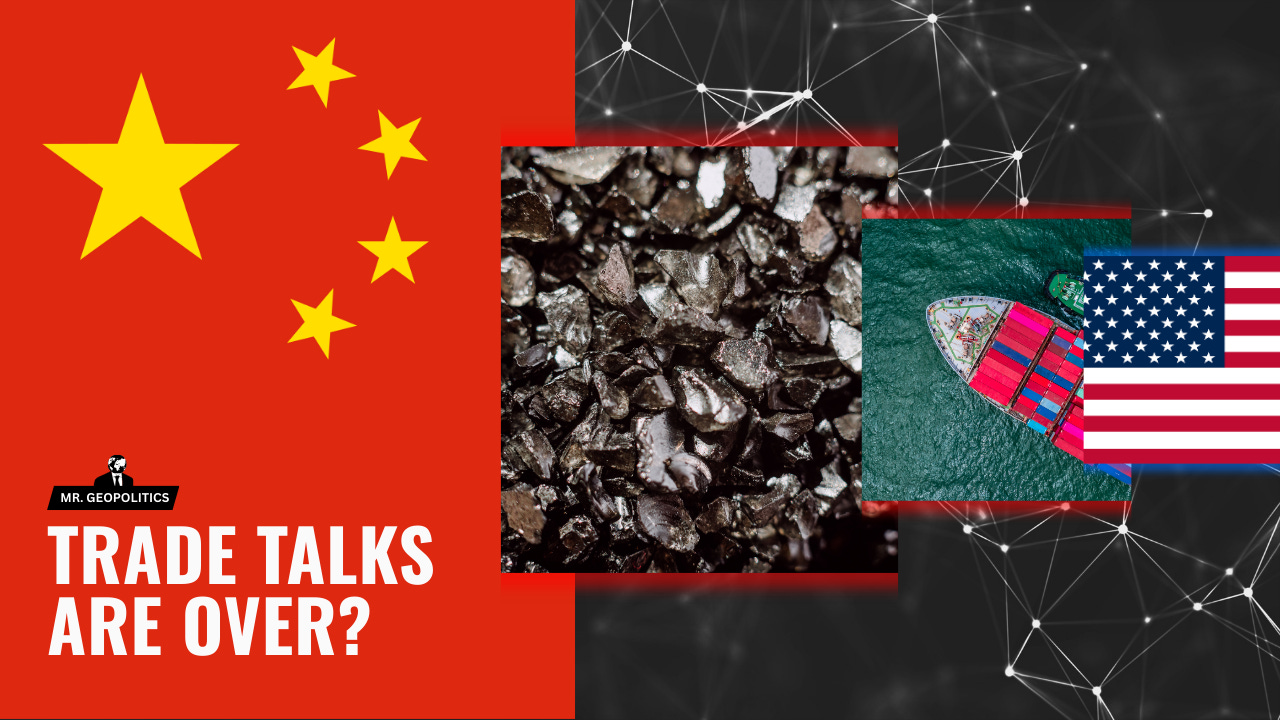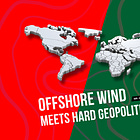A New US-China Resource War
The April detente is reaching its end
A destabilization of global resource markets is beginning as the US and China refuse to capitulate to one another. Ideas of a rapprochement, or trade breakthrough, are quickly fading, returning Washington and Beijing to the dangerous position they were in a few months ago in April.
China's latest move with rare earths signals that a new resource war is about to begin, threatening supply chains and the economic security of nations across the globe.
Every year, often twice (H1 and H2), Beijing sets ceilings that control production (including mining) and export of rare earths in and from China. This is referred to as the “rare earth quota system.” The measures were a multi-front strategy unveiled by China in the 20th century, as it quickly overtook the US as the leading exporter of rare earths. The plan was to raise prices (i.e., controlling production = less supply = higher prices) and, simultaneously, attract foreign investment (if businesses wanted more access to rare earths, instead of fighting for limited stock on global markets, they could establish operations within China itself).
Since its introduction in two phases (1998 and 2006), the quota system has been focused exclusively on rare earths mined and processed inside China.
But on August 22nd, all of this changed. The Chinese government suddenly expanded the parameters to include imports of rare earths, pushing global supply chains to the brink. The door is opening to a massive showdown between the world’s two largest economies that will make businesses and governments dizzy.
📣 POPULAR INSIGHTS ON THIS TOPIC
Global mining companies that export raw rare earths to China for processing (i.e., China processes 90% of the world’s rare earths) now face potential limits on how much can be refined and converted into magnets, which are then sold to the likes of Apple and Samsung, to be used in the manufacturing of everything from smartphones to appliances.
All of this might sound very technical.
At its core, what it means is that China can now decide to stop processing “foreign rare earths” that global, mainly Western firms, rely on. China can paralyze supply chains in a new way.
CHINA’S STRATEGY
This is an expansion of China’s weaponization of rare earth exports.
Since April, Beijing has been restricting rare earth exports to the global economy, sounding alarm bells. In May, for example, Chinese exports of rare earth magnets dropped a shocking 74% (year-on-year). Now, instead of just throttling exports, China can specifically control and limit the processing of foreign rare earths, introducing a “dual shortage” as global rare earth supplies are limited (i.e., China is already controlling exports) and processing for foreign companies is restricted (i.e., reducing the supply of rare earths even more).
Just as China’s decision to target rare earth imports is stunning, so is the world’s response.
US President Donald Trump has threatened a 200% tariff on China if America’s access to rare earth magnets is throttled, further putting trade talks on ice. US-based MP Materials, one of the largest rare earth producers in the world, which operates the only rare earth mine and processing facility in the country, has halted the export of raw rare earth metals to China. MP Materials is at the heart of the new US attempts to rebuild rare earth supply chains that do not rely on China.
There is no sign that Beijing is backing down — or that China is about to impose new curbs on rare earth production. However, by changing the quota system, China has put this card on the table. And the timing is no coincidence. The Chinese government is making it clear what will happen if the US does not meet its trade demands: chaos, chaos, chaos.
What these trade demands are, however, remains vague but likely revolves around America retracting the majority of limits on critical goods like chips, design software, and industrial equipment (i.e., those used to build commercial planes), and potentially even US guarantees to restrict support for Taiwan.
RESOURCE WAR
Multiple “geopolitical avenues” are now activated that stakeholders must pay close attention to:
First, unless China promises to leave rare earth magnet flows to the US uninterrupted, the critical metals are about to become the defining point in whether US-China trade talks can advance or not. Already, the trade talks have been rocked by US Commerce Secretary Howard Lutnick’s remarks on TV, when he discussed US chip exports to China and said, “We don’t sell them our best stuff, not our second-best stuff, not even our third-best.” The response from China was to instruct its local firms to stop buying Nvidia chips. It is not far off to say that Lutnick’s comments have likely influenced China’s new rare earth decision, a message to US officials (and Trump) to pick words carefully, as China is done playing nice.
If the White House cannot see past the rare earth quota change, the US could return to tariffs or cut the flow of vital resources to China, including chips and capital, resuming the trade war.
Second, the rest of the world is being held hostage to an ever-growing shortage of critical metals, fueled by US-China tensions. This is likely to result in three main pushes by governments:
Build new sovereign or friendly supply chains that cut reliance on Chinese critical metals (i.e., what Canada and Germany have just inked, coincidentally, days after Beijing’s rare earth move).
Rapidly stockpile and hoard supplies of rare earths, scouring global markets in a way that causes friction as economies clash to acquire resources like never before.
A new era of resource protectionism as countries restrict their own rare earth exports (i.e., what India has done with Japan), and other nations with huge reserves ban or restrict raw exports to ride the wave, and attract investment from desperate nations/businesses.
The steps the rest of the world takes are likely to exacerbate the new US-China resource war. Even allied states could now be competing to scoop up rare earths and other critical metals across the globe.
Third, there is now a big “grey area” over Russia and its rare earth supplies. While Russia produces just 1% of global rare earths, it wants to raise this share to 12% by 2030, making it a top-five critical metals producer. If the US and China are clashing, and Beijing restricts rare earths even more, attention will turn to countries that can supply and offset China’s decisions, putting the spotlight squarely on Moscow.
This means the US-China resource war and the Ukraine-Russia war will be linked. The US may recalibrate its threats against Russia (i.e., secondary sanctions), putting its resource security ahead of punishing the Kremlin and its partners. If the shortage of earth supplies worsens, the US (and the West) may have no choice but to allow Russia back into the global economy to access critical metals.
Fourth, and lastly, the appetite in the West to build non-Chinese supply chains will reach a new level after the latest move by Beijing. Investments in countries like Australia, innovation around rare earths recycling, and R&D around manufacturing products without certain critical metals, will also receive their most significant injection in modern times, even if purely attention and momentum from Western governments.
The rise of “vertical globalization” (i.e., a world full of walls and barriers) is about to accelerate, as the West seeks to build new supply chains, internally (within Western states) and between each other, that leave out China. And, on the other side, China weaponizes rare earths against its adversaries.
DOMINO EFFECT
This last part requires special attention, where China restricts the export of rare earths against specific nations with which it has problems. What China has done with its quota system is not only a message to the West. It is a message to every nation: mess with China, and experience supply chain disruption.
One nation that is likely watching this very closely is India.
As the US raises the heat on India, imposing 50% tariffs and threatening further measures unless New Delhi stops importing energy from Russia, a new rapprochement has begun between India and China. Later this week, Indian Prime Minister Narendra Modi will visit China after 7 years, standing alongside Chinese President Xi Jinping, Russian President Vladimir Putin, and a host of other leaders, including the Prime Minister of Pakistan, at the annual Shanghai Cooperation Organization (SCO) summit.
For now, the India-China relationship is (slowly) moving onto more stable ground as both governments battle the same challenge: America First. But, in the blink of an eye, this could change, in particular over border tensions. The moment this happens, India’s access to Chinese rare earths could be further cut.
At the same time, both Malaysia and Indonesia have unveiled new measures for rare earths.
A day after China’s quota announcement, the Malaysian government said that it will ban the export of raw rare earth minerals. This is a strategic move by Kuala Lumpur. While Malaysia does not have significant rare earth reserves, it does process a considerable amount. The Lynas plant in Pahang, a state east of the capital, produces 12% to 15% of the world’s rare earths. By restricting exports, Malaysia is forcing foreign investment into the country. In tandem, Indonesia has unveiled it will be establishing a new government department that will oversee the development of the country’s rare earth sector—along with “radioactive materials” (likely pointing to nuclear fuel and uranium for nuclear energy plants).
Clearly, Southeast Asia is not staying quiet. The US-China resource war is prompting Kuala Lumpur and Jakarta to step into the fold in their unique ways. And these nations will not be the last, meaning the borders of the US-China resource fight are expanding in all directions.
CONCLUSION
Every day, a new geopolitical fight is beginning. The last few days are no exception—first, the US attack on Orsted, the Danish firm, and now, the Chinese move against global rare earth supplies, entirely under Beijing’s control.
The world is being pushed, not just to deal with a new US-China resource war, but to adapt to a new period of resource insecurity. This will force governments to take bold, unilateral action to strengthen their economic security. Compounded with the rising wave of nationalism across the globe, countries could do the unthinkable, from deals to alignment.
For China, which is currently in a position of power, diminishing returns are incoming. In the short term, the world will bend and move to China’s whim to maintain access to rare earths. But, in capitals and corporate boardrooms, work will be sped up to build rare earth sovereignty and cut reliance on China (and anyone else). The Chinese move with rare earths has not just ignited a resource war; it has pushed the world to begin the complicated affair of permanently decoupling from China in certain avenues.
-ABISHUR PRAKASH AKA. MR. GEOPOLITICS
Mr. Geopolitics is the property of Abishur Prakash/The Geopolitical Business, Inc., and is protected under Canadian Copyright Law. This includes, but is not limited to: ideas, perspectives, expressions, concepts, etc. Any use of the insights, including sharing or interpretation, partly or wholly, requires explicit written permission.
Have questions or thoughts? Let’s talk: mrgeopolitics@substack.com
If you like Mr. Geopolitics, your colleagues might too.
Feel like doing something unique for somebody important?








